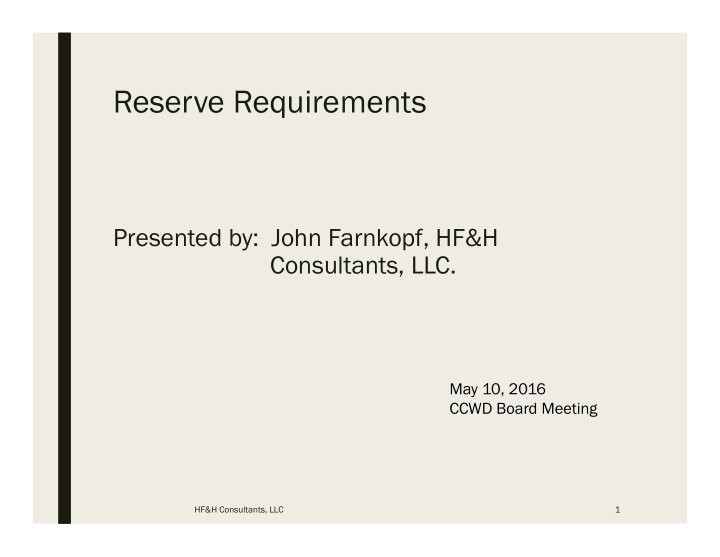



Reserve Requirements Presented by: John Farnkopf, HF&H Consultants, LLC. May 10, 2016 CCWD Board Meeting HF&H Consultants, LLC 1
Reserve Requirements ■ Purpose of reserves – Account for revenues – Manage risks ■ Two broad categories – Unrestricted reserves Established as needed • Typically funded from rate revenue • – Restricted reserves Legally required according to funding source • HF&H Consultants, LLC 2
Common Types of Reserves HF&H Consultants, LLC 3
Unrestricted Reserve Practices ■ No absolute standard ■ All water utilities have at least one unrestricted reserve ■ Most have separate unrestricted reserves for operating and capital requirements ■ Some have additional unrestricted reserves to help manage special requirements – Reflects approaches to managing risk HF&H Consultants, LLC 4
Operating Reserve ■ Highest priority unrestricted reserve ■ Purpose – Cash flow – cover lag time between when District pays expenses and receives revenue from rate payers – Manage operating surpluses and deficits caused by variances between projected and actual expenses and revenues Unpredictable changes in costs outside the District’s control • – Cost of SFPUC purchased water – Cost of power and chemicals for pumping and treatment Buffer fluctuating water sales caused by climate and water supply • conditions – Smooth rate increases from year to year HF&H Consultants, LLC 5
Operating Reserve ■ Target balance – To cover cash flow, bill frequency is a key consideration – California PUC rule of Thumb Minimum = 1.5 times bill frequency • For bi-monthly billing, 90 days of revenue • Equivalent to 25% of annual operating • revenue HF&H Consultants, LLC 6
Capital Reserve ■ Second highest priority unrestricted reserve ■ Purpose – Cash flow for pay-as-you-go capital projects Provides liquidity to pay contractors without • construction delays – Not needed for debt-funded projects when there is a separate restricted Debt Reserve – District does not have a Debt Reserve Can include an allowance for one year’s debt • service in the Capital Reserve or create a separate Debt Reserve HF&H Consultants, LLC 7
Capital Reserve ■ Target balance – Industry practice varies considerably – Considerations that increase requirements Significant annual fluctuations in costs construction costs • Preference to fund capital projects without debt • Predictable facility master plans • Uncertain regulatory environment • Unfavorable bidding economics • Low tolerance for asset failures, natural disasters, and • other emergencies – Minimum recommended Annual average for next five years CIP • HF&H Consultants, LLC 8
Emergency Reserve ■ Lower priority – Provide funding after Operating and Capital Target balances are met ■ Purposes – A type of capital reserve for self insurance – Can be targeted toward a specific facility outage – Provides immediate funding until loans are arranged and before rates can be increased HF&H Consultants, LLC 9
Stabilization Reserve ■ Lower priority – Provide funding after Operating and Capital Target balances are met ■ Purposes – A type of operating reserve – Used to stabilize rate increases caused by uncertain operating conditions Conservation during droughts • Reduces need for rate increases that make rate payers feel • penalized for using less Can be funded from surpluses in years of high water sales • without the need for rate increases HF&H Consultants, LLC 10
Meeting Reserve Targets ■ Unrestricted reserves are funded from rate revenue – Building reserves requires rate increases – To avoid chasing the targets, affirmative rate increases may be needed Try to avoid deferring capital projects to build • reserves Rely on realistic conditions to close the gap • Earlier action can take advantage of the • compounding of subsequent rate increases HF&H Consultants, LLC 11
Evaluation of District’s Operating Reserve ■ Current – 15% of operating revenue – Intended for other unrestricted reserve needs ■ Recommendation – Should be a minimum of 25% – Rate increase required HF&H Consultants, LLC 12
Evaluation of District’s Capital Reserve ■ Current – None – Not separate from Operating Reserve ■ Recommendation for PAYGo CIP – Create separate Capital Reserve – Annual average for next five years ■ Recommendation for debt-funded CIP – One year’s maximum annual debt service – Can be included in Capital Reserve in addition to PAYGo component Better as a separate Debt Reserve • – Rate increase required HF&H Consultants, LLC 13
Recommend
More recommend